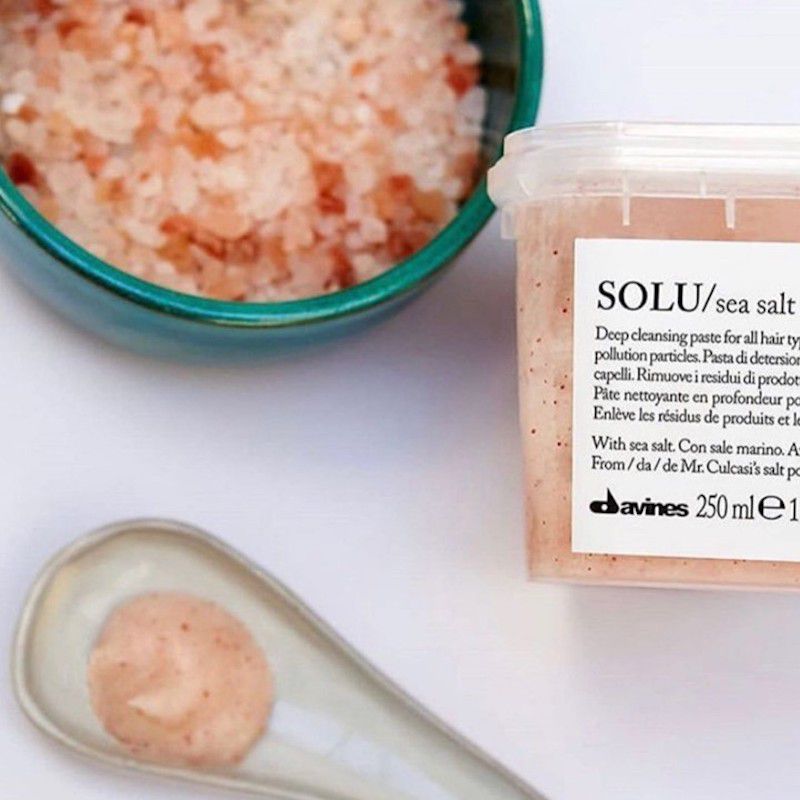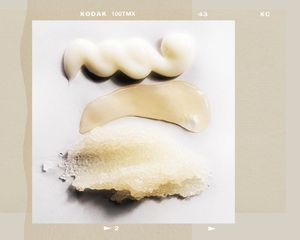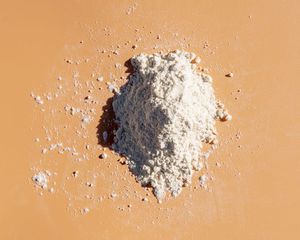
Stocksy/Design by Cristina Cianci
Dandruff can sneak up on us when there's a change in climate, diet, products, and so much more. Since our skin is the largest organ of our bodies—scalp included—it can be the first place that symptoms of underlying issues tend to reveal themselves. Dandruff may actually be your scalp's cry for help.
There's more than one type of dandruff. The most commonly known dry dandruff is white and usually sheds from the scalp to make an appearance on our shoulders (ick, no thank you). Then there's oily dandruff, which typically appears to be a yellow color and adheres to the scalp, as described by board-certified dermatologist Sumayah Jamal, MD. "It is caused by a yeast called malassezia furfur that is part of the normal skin flora," Jamal says.
Oily dandruff is also referred to as seborrheic dermatitis, explains certified trichologist William Gaunitz. "[This] is an inflammatory scalp condition in which your body is overproducing skin cells in a particular area of the scalp and overproducing sebum (natural oils), which creates a compounded scalp flaking," he says. All that excess oil is what causes flaking skin to stick to the scalp, as Jamal notes. Oily dandruff may be accompanied by itchiness and tenderness. In extreme cases, Gaunitz warns that oily dandruff can extend beyond the hairline and onto the forehead, or even lead to hair loss. Thankfully, there are plenty of ways to alleviate the condition. Below, our experts advise on how to fight back against oily dandruff.
Meet the Expert
- Sumayah Jamal, MD, is a board-certified dermatologist at Schweiger Dermatology Group in New York City.
- William Gaunitz, WTS, is a certified trichologist and the founder of Advanced Trichology.
Use a Scalp Scrub

Generally speaking, using a scalp scrub is a great hygienic practice for anyone. But it's particularly important for anyone showing signs of oily dandruff. Scrubs can eliminate excess oil and skin by way of exfoliation, while still maintaining a healthy level of moisture. Using a scalp scrub to eliminate excess buildup—even if one doesn't have dandruff or it isn't at a point of severity—can help to generate blood circulation, which is crucial to maintaining good scalp health.
Jamal suggests using a gentle scrub one to two times a week. "Oily dandruff is indeed on the mild end of the psoriasis spectrum," she tells us. Since psoriasis is an inflammatory disease, Jamal warns not to scrub, brush, or scratch the scalp too vigorously, as that could create a worse outcome for the irritated area(s).
Switch Shampoos

Shampooing plays a major role in scalp care. Whatever you choose to lather up against those scaly, itchy spots is definitely something to consider. Gaunitz suggests switching to an antifungal shampoo like this HairStem formula. Products like HairStem that contain ingredients like tea tree oil, rosemary, and lavender promise to stop microbe growth and assist in preventing the overproduction of skin cells. It also contains jojoba oil and aloe, which are known to reduce inflammation. These are the types of ingredients you want to look for when making the switch to a better-suited shampoo.
Jamal highlights a few other helpful key ingredients to keep an eye out for when switching up shampoos, such as zinc pyrithione, ketoconazole, and apple cider vinegar. These ingredients can be found in products like Head & Shoulders Dandruff Shampoo and are meant to help reduce the number of organisms, again decreasing the overgrowth that characterizes oily dandruff. You'll also want ingredients that reduce scales, she says, such as salicylic acid, willow bark, or phenol. Tar derivatives can also help at reducing inflammation.
Shampoo Frequently

Once you've switched the type of shampoo you're using, it's time to put those key ingredients to work. Gaunitz states that washing your hair daily with a natural shampoo and conditioner with the right properties to fight oily dandruff is part of slowly but surely eliminating excess buildup.
If shampooing twice a week seems like an increased frequency from your current routine due to your hair type, Gaunitz suggests Nizoral's Anti-Dandruff Shampoo. "This is an over-the-counter antifungal shampoo that helps block any fungus that may be feeding off the increased oil harbored between the un-exfoliated skin cells," he says. If more frequent shampoos means twice a week for you, sticking with a stronger over-the-counter shampoo is the way to go to ensure that your scalp is getting the most impactful treatment each time.
Maintain a Healthy Diet

Getty Images
A change in diet can also make a significant impact on your scalp's health. The same way you might experience a breakout after greasy food, or puffiness after drinking, the scalp can experience a reaction from poor nutrition. "Decrease unhealthy fats and sugar in your diet, like fried foods and processed sugar," Gaunitz advises. Seborrheic dermatitis has a large fungal component, he notes, and decreasing the chances of a fungal flare up may happen by eliminating high glucose foods from being dumped into your system. Avoiding these types of poor eating habits will help decrease inflammation, he says.
Gaunitz also suggests upping your intake of healthy fats. "Consuming healthy fats in the form of omega 3-6-9 can help reduce the inflammatory effects and soothe itching and burning." Foods that are high in healthy fats and omegas include fish, nuts, and plant oils.
Regularly Apply Scalp Treatments

Scalp treatments are great remedies for oily dandruff because many of them have ingredients with anti-fungal and anti-inflammatory properties. Dr. Jamal recommends Eucerene's DermoCapillaire Anti-Dandruff Scalp Treatment, which contains Licochalcone A, an ingredient derived from Chinese licorice root that soothes the skin with its antioxidant and anti-inflammatory properties. Massaging treatments into the scalp one to two times a day, with or without shampooing, will not only help clear the scalp but can provide soothing relief to any itchiness you're experiencing.
If you've no time to run to the store for an over-the-counter medicated treatment, Gaunitz suggests using extra-virgin raw coconut oil, which is also anti-fungal and anti-inflammatory. It may temporarily help with hydration and flaking. "Warm the coconut oil to room temperature and apply directly to the scalp, massaging it in," he says. "Let it sit for 45 minutes to an hour before rinsing out to shampoo and condition. You can do this up to three times a week."
Put Away Your Styling Products

With so much healing happening at the scalp, the last thing you want to do is pile on any additional irritants. Sadly, this may mean storing away some of your beloved styling products. Any chemical-based products or alcohol-containing aerosols, like dry shampoo for example, is not going to fly while you're warding off oily dandruff. "Think of the scalp like an open wound," Gaunitz explains. "You only want healing things on that area." If a product doesn't have healing properties for the inflammation and irritation you're already experiencing, your best bet is to tuck it away for a later date or pass it off to a friend. Keep your products clean and oriented around what's happening at the scalp until you are no longer experiencing any symptoms.
So how long does it take to get your scalp back to its normal, non-itchy state of zen? "To see promising results with any of these treatments you would need to allow typically between three to four weeks for there to be a noticeable sign of remission," says Gaunitz. And it's highly probable that more than one of these treatments will be needed, he notes. "It’s best to use a multi therapeutic approach. You could theoretically use all of the recommendations listed to put down the seborrheic dermatitis as quickly as possible."
If four to six weeks goes by and you've seen no improvement after using these treatments, "you may need prescription strength medications," says Jamal. At that point, you'll want to go see your dermatologist for help.
















